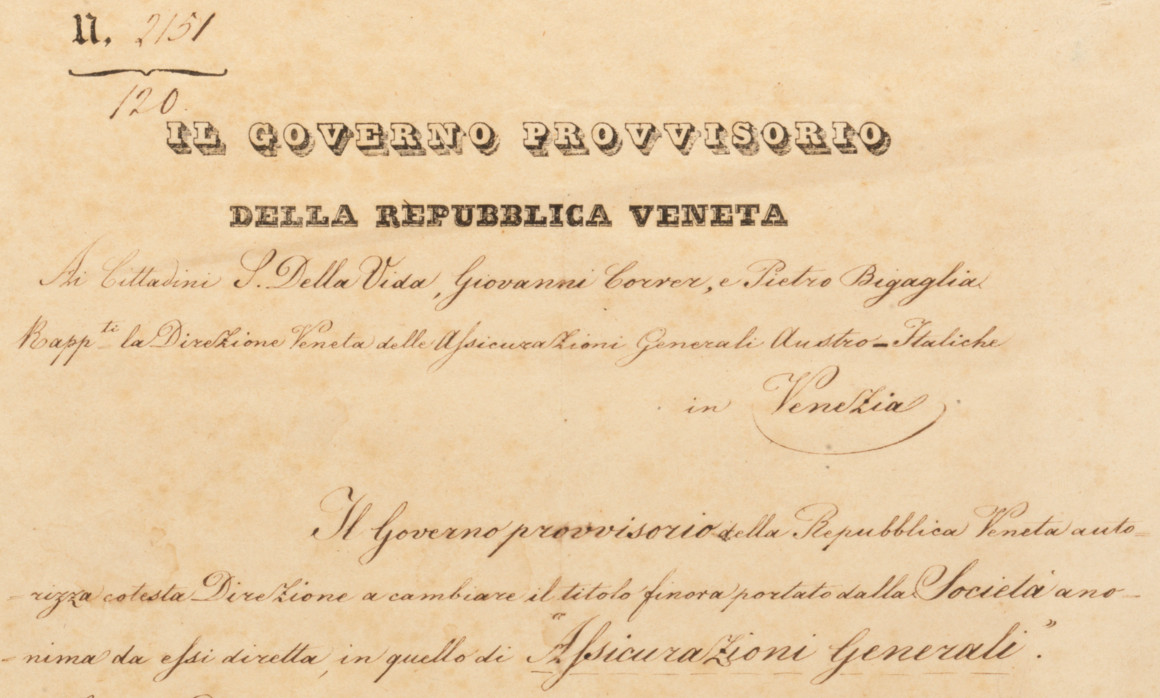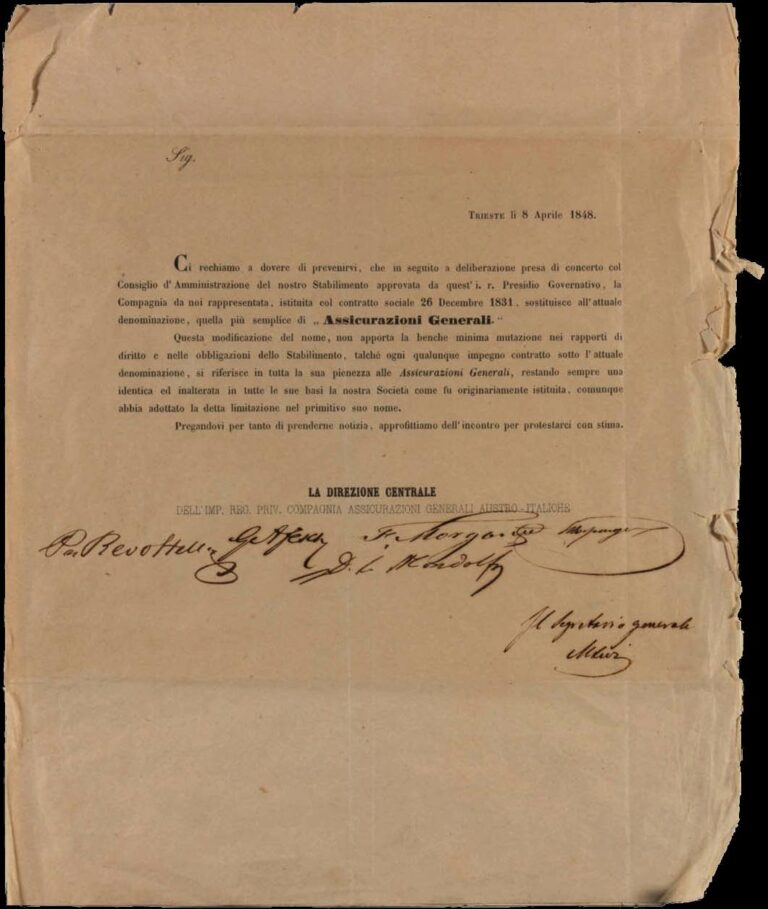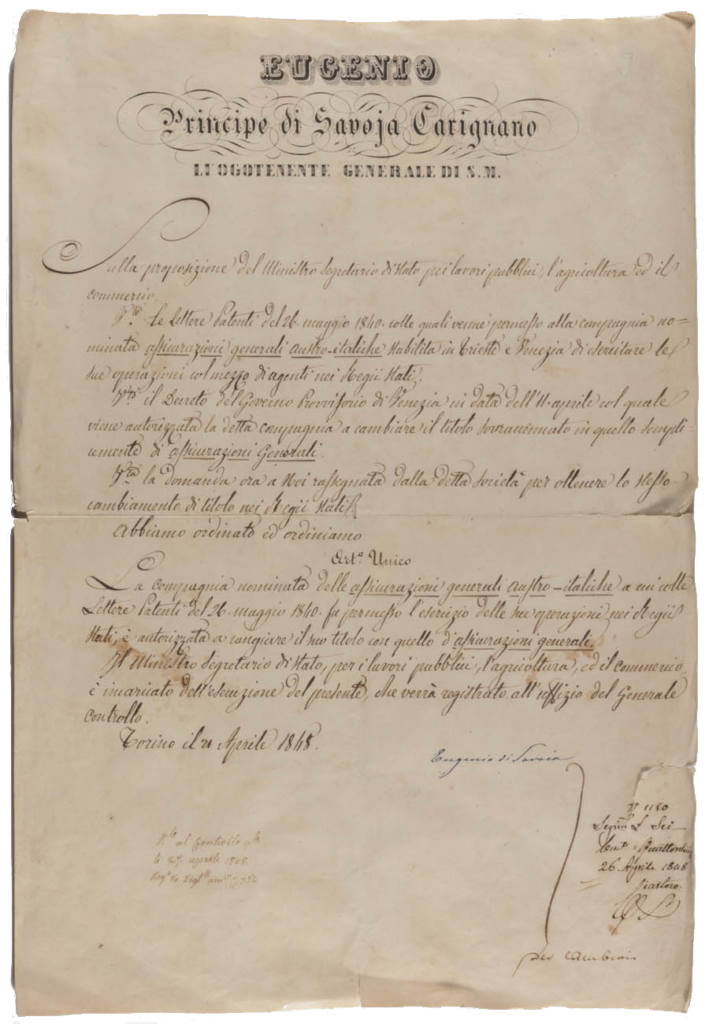…and the Eagle became a Lion
15 November 2017
Historical Archive Generali
The revolutionary movements that shook Europe in 1848 also struck Generali. Since January 1833, with governmental approval, the company founded in 1831 as “Assicurazioni Generali Austro-Italiche” had operated under the Habsburg double-headed eagle symbol. On 28 March 1848, the Trieste management discussed the need for a different image despite being less sympathetic towards Italophile strains than their Veneto counterparts. With remarkable pragmatism, a change of company name was suggested as an answer to the violent protests affecting the Italian peninsula in particular, and to blur the now uncomfortable link with Habsburg rule, for which there was scant public affection at that delicate historical juncture.
The question was put to the Board of Directors a few days later. The secretary-general Masino Levi stated that “First in Tuscany and then in the Kingdom of Naples during the political upheavals and the popular fervour against the Austrian Powers opposing change, the people have taken to insulting and destroying our company’s emblem with the Imperial eagle and then, considering our company a supporter of the Austrian government by virtue of it being called Imperial Royal Privileged Assicurazioni Generali Austro-Italiche, they initiated a crusade against us to paralyse our operations in those two States. The same behaviour, and even more violent, was displayed by the public against us in all the cities in the Kingdom of Lombardy-Venetia […]”. It was therefore decided to trim the Company’s name by dropping the “Austro-Italiche” qualification, to seek government approval and, having obtained it, to inform shareholders and the public of thedecision, while confirming that commitments already undertaken would be honoured.
These first fundamental steps were followed by official approval from various Italian states, led by the Provisional Government of the Venetian Republic, geographically and politically closer to the Venice management, representing Generali’s Italian soul. By a Decree of 11 April 1848, soon after the proclamation of the new Venice government, the Company’s decision was accepted with the proviso that its administrative structure should remain substantially unchanged.
The text bears the signature of President Daniele Manin, accompanied by that of Leone Pincherle. The latter, former secretary to Generali’s Management in Venice had been appointed Minister of Agriculture and Trade in the Lagoon City government. Other important Company officials in Venice, such as Daniele Francesconi and Isacco Pesaro Maurogonato, played an active role in the brief life of the infant Republic.
Approvals also arrived from the provisional government of Lombardy and the Kingdom of Sardinia, issued in the lattercase by Prince Eugenio Emanuele of Savoy-Carignano, Lieutenant General of the Kingdom and distant cousin of King Carlo Alberto who was then engaged in what would become known as the First Italian War of Independence. The final act was a statutory ratification of the company name change, approved unanimously at the Shareholder Meeting of 31 July 1848.
The change of name was accompanied by a decision to remove the two-headed eagle symbol from signs and policies throughout Italy and, from 1860, to stamp documents with the winged lion of Saint Mark, the ancient symbol of the Serenissima, as a sign of independence from Austrian rule. In the rest of the Empire, however, the Habsburg symbol remained in use until the end of the First World War.
For further details see: M. MARIZZA, A New Company Name. From “Assicurazioni Generali Austro-Italiche” to “Assicurazioni Generali”, in Generali in History. Tales from the Archives. Nineteenth Century, Venice, Marsilio, 2016, pp. 146-149. For the history of the Company symbol, refer to P. EGIDI, From Eagle to Lion. The Company’s Evolution in Spirit and Symbols, ibid., pp. 35-45.








